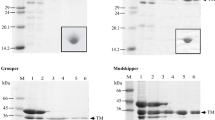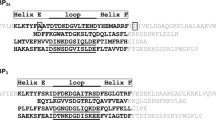Summary
Parvalbumins were isolated from skeletal muscles of a tropical amphibian, Leptodactylus insularis, and three new isotypes were identified. The total concentration of parvalbumins in L. insularis was the same as the total amounts found in an amphibian from the temperate or variable zone (Rana temporaria). Muscles of the thigh and foreleg had the maximum parvalbumin concentration (0.35 mmol · kg wet weight-1). Samples from pectoralis and rectus abdominis muscles had significantly less (0.29 mmol · kg-1). Three previously unknown parvalbumin isotypes (IV, IIIa, and IIIb) were isolated from the tropical amphibian. They were different from the isotypes (IVa and IVb) predominant in R. temporaria skeletal muscle. Parvalbumins are thought to have a role in the short-term removal of myoplasmic Ca2+ during muscle relaxation. Hence, the unique isotypes in L. insularis may reflect optimal molecular adaptations retained during the animal's evolution in a constantly warm environment.
Similar content being viewed by others
Abbreviations
- DEAE :
-
diethylaminoethyl
- ELISA :
-
enzyme linked immuno sorbent assay
- SPDP :
-
N-succininydyl-3-(2-pyridyldithio) propionate
- SR :
-
sarcoplasmic reticulum
References
Blinks JR, Rüdel R, Taylor SR (1978) Calcium transients in isolated amphibian skeletal muscle fibres: Detection with aequorin. J Physiol 277:291–323
Blum HE, Lehky P, Kohlen L, Stein EA, Fischer E (1977) Comparative properties of vertebrate parvalbumins. J Biol Chem 652:2834–2838
Cannell MB (1986) Effect of tetanus duration on the free calcium during the relaxation of frog skeletal muscle fibers. J Physiol 376:203–218
Gerday C (1982) Soluble calcium-binding proteins from fish and invertebrate muscle. Mol Physiol 2:63–87
Gerday C, Gillis JM (1976) The possible role of parvalbumins in the control of contraction. J Physiol 258:96P
Gerday C, Joris B, Gerardin-Otthiers N, Collin S, Hamoir G (1979) Parvalbumins from the lungfish. Biochimie 61:589–599
Gillis JM (1985) Relaxation of vertebrate skeletal muscle. A synthesis of the biochemical and physiological approaches. Biochim Biophys Acta 811:87–145
Gillis JM, Thomason D, Lefevre J, Kretsinger RH (1982) Parvalbumins and muscle relaxation: a computer simulation study. J Muscle Res Cell Motil 3:377–398
Godt RE, Lindley BD (1982) Influence of temperature upon contractile activation and isometric force production in mechanically skinned muscle fibers of the frog. J Gen Physiol 80:279–297
Goodman M, Pechere JR, Haiech J, Demaille J (1979) Evolutionary diversification of structure and function in the family of intracellular calcium-binding proteins. J Mol Evol 13:331–352
Gosselin-Rey C, Bernard N, Gerday C (1973) Conformation and immunochemistry of parvalbumin III from pike white muscle. Biochim Biophys Acta 303:90–104
Gosselin-Rey C, Gerday C (1977) Parvalbumins from frog skeletal muscle. Biochim Biophys Acta 492:53–63
Heizmann CW, Berchtold MW, Rowlerson AM (1982) Correlation of parvalbumin concentration with relaxation speed in mammalian muscle. Proc Natl Acad Sci USA 79:7243–7247
Huch R, D'Haese J, Gerday C (1988) A soluble calcium-binding protein from the terrestrial annelid Lumbricus terrestris, L. J Comp Physiol B 158:325–334
Jauregui-Adell J, Pechere JF (1978) Parvalbumins from coelacanth muscle. Biochim Biophys Acta 536:263–268
Klug GA, Leberer E, Leisner E, Simoneau J, Pette D (1988) Relationship between parvalbumin content and the speed of relaxation in chronically stimulated rabbit fast-twitch muscle. Pflügers Arch 411:126–131
Kretsinger RH, Nockolds CE (1973) Carp muscle calcium-binding protein. J Biol Chem 248:3313–3326
Lopez JR, Caputo C, Taylor SR (1982) The influence of temperature on responses of skeletal muscle from a tropical amphibian Leptodactylus insularis. Biophys J 37:127a
Pechere JF, Derancourt J, Haiech J (1977) The participation of parvalbumins in the activation-relaxation cycle of vertebrate fast skeletal-muscle. FEBS Lett 75:111–114
Smith M (1949) British reptiles and amphibia. Penguin Books, Harmondsworth, Middlesex, pp 1–50
Smith SJ, Woledge RC (1985) Thermodynamic analysis of calcium binding to frog parvalbumin. J Musc Res Cell Mot 6:757–768
Tanokura M, Imaizumi M, Yamada K (1986) A calorimetric study of Ca2+ binding by the parvalbumin of the toad (Bufo): distinguishable binding sites in the molecule. FEBS Lett 209:77–82
Woledge RC, Curtin NA, Homsher E (1985) Energetic aspects of muscle contraction. Academic Press, London, pp 1–357
Author information
Authors and Affiliations
Rights and permissions
About this article
Cite this article
Gerday, C., Goffard, P. & Taylor, S.R. Isolation and characterization of parvalbumins from skeletal muscles of a tropical amphibian, Leptodactylus insularis . J Comp Physiol B 161, 475–481 (1991). https://doi.org/10.1007/BF00257902
Accepted:
Issue Date:
DOI: https://doi.org/10.1007/BF00257902




